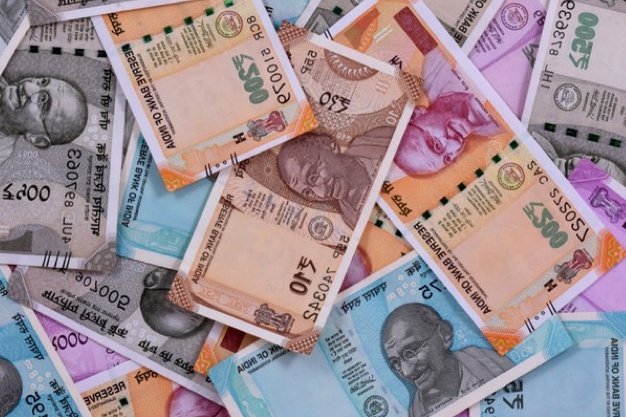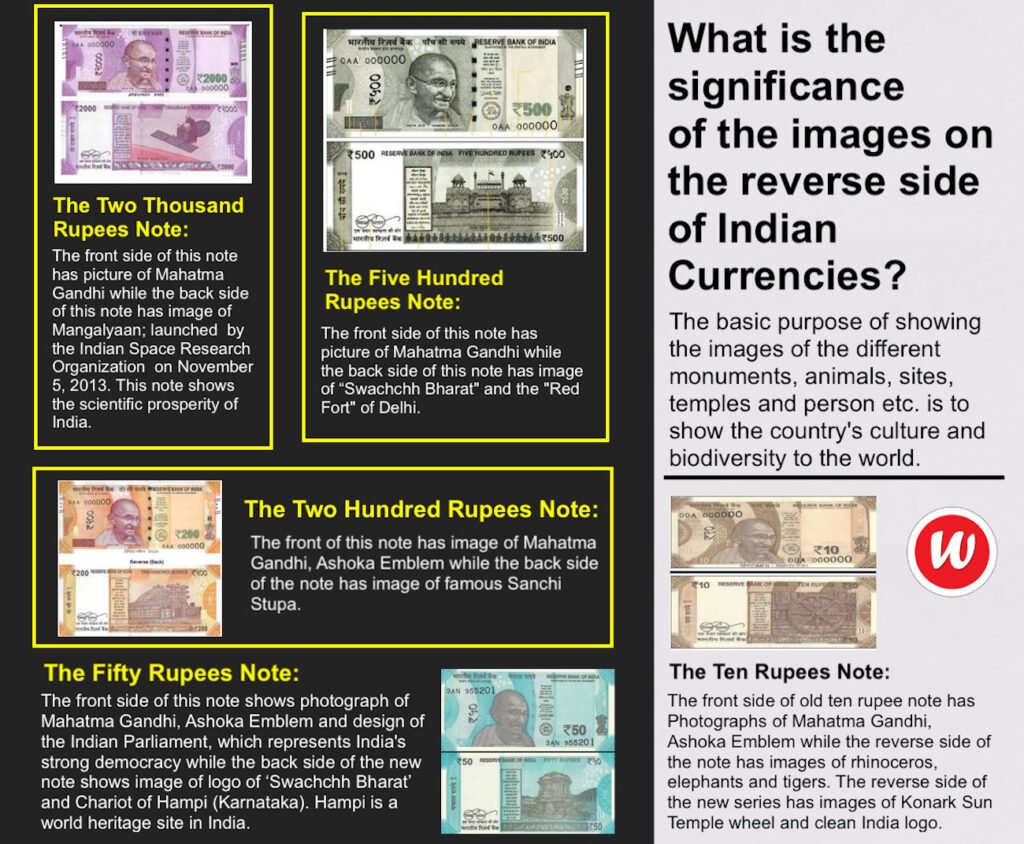What is the Significance of Images on Indian Currency?

Our entire life turns around money, and if there’s one thing that makes people happy, it’s the money because it gets us most of the things we want and need.
But if we ask you, have you ever observed Indian currency barely to mark the pictures on it and there meaning? Parents are busy earning money and giving it further to get the things and services, but have you ever noticed? Today, we’ll talk about the images on various notes of Indian currency and what they mean.
Let’s have a look at the various Images on Indian Currency on the reverse side of the Indian notes:
1. One Rupee Note(Re 1 Note) :
One rupee note is not popular these days. It has the picture of an oil rig which implies the industrial growth and development of the country.
One Rupee note was first printed in India during World War I. Earlier, in the country silver coins of one rupee with a picture of George V was in circulation.
But due to the world war I, the supply of silver coins shorten and hence the government printed the one rupee note on November 30, 1917. The Ministry of Finance prints one rupee note, not by the RBI.
2. Two Rupees Notes (Rs. 2 Note):
Another Indian currency note not used enough today. Two rupee note has the picture of Aryabhatta satellite, which is the sign of Science and Technology’s progress in India.
Although the RBI has stopped the printing of 2 rupee note due to the higher cost of the printing. These old notes still legal tender.
3. The Five Rupees Note(Rs. 5 Note):
The front side of the note has the picture of Mahatma Gandhi. The reverse side of the note has the picture of a farmer ploughing the field. It represents the agricultural growth of the country.
Due to the increasing cost of printing of these notes, the RBI has stopped its printing, but 85,000 million notes of this denomination are still legal in the market.
4. The Ten Rupees Note(Rs 10 Note):
The front side of the old ten rupee note has Photographs of Mahatma Gandhi, Ashoka Emblem. The reverse side has images of Konark Sun Temple wheel and clean India logo, which means the country’s cultural heritage.
Notes ranging from 1 rupee to 10 rupees go quickly from one hand to another, that is the reason they get rough fast. To solve this problem, the government decided to mint the coins of this value. The cost of printing of one 10 rupee note is around 96 paisa.
5. The Twenty Rupees Note(Rs 20 Note):
The front part of this note has Photo of Mahatma Gandhi (Water Mark), Ashoka Emblem, while the reverse side of the note has a picture of palm trees which shows the view of “Mount Harriet Light House” in Port Blair.
The cost of printing of 20 rupees note is equal to 10 rupees note. There are 5000 million notes of this denomination in the circulation in the market.
6. The Fifty Rupees Note(Rs 50 Note):
The front side of this note shows a photograph of Mahatma Gandhi, Ashoka Emblem and design of the Indian Parliament, which depicts India’s strong democracy, while the reverse side shows the image of the logo of ‘Swachchh Bharat’ and Chariot of Hampi (Karnataka). Hampi is a world heritage site in India.
The cost of printing of a 50 rupees note is around Rs. 1.81 and 4000 million notes of this denomination are in the circulation currently.

7. The Hundred Rupees Note(Rs 100 Note):
The front side of this note has an image of Mahatma Gandhi, Ashoka Emblem, while the reverse side of this note has a picture of “Mount Kanchenjunga,” the highest mountain in India.
The cost of printing this note is 1.20 rupees, and 16,000 million notes of this value are in circulation in the market.
8. The Two Hundred Rupees Note(Rs 200 Note):
The front side of the note has an image of Mahatma Gandhi, Ashoka Emblem, while the reverse side of the note has a picture of famous Sanchi Stupa.
Notes of this denomination have been printed for the first time in India. The cost of printing of a note of 200 rupees is around Rs 2.93.
9. The Five Hundred Rupees Note(Rs 500 Note):
After the demonetization in 2016; the new notes have replaced the old notes of 500 and 1000 rupees.
The reverse side of this note has an image of “Swachchh Bharat” and the “Red Fort” of Delhi.
The cost of printing of a new five hundred currency note is around Rs. 2.94.
10. The Two Thousand Rupees Note(Rs 2000 Note):
The front side of the note has a picture of Mahatma Gandhi, while the reverse side of this note has an image of Mangalyaan; launched by the Indian Space Research Organization on November 5, 2013. This note shows the scientific prosperity of India.
This note has been printed for the first time in India. Due to high-level security features, the cost of printing of this note is around Rs 3.54.
All the currency notes are minted at the following location according to the government of India. India Government Mint (SPMCIL) – Mumbai, Hyderabad, Kolkata and Noida.
Conclusion
Thus, by looking at all the notes and Images on Indian Currency given above, we can say that India has worked to prove the saying of ‘unity in diversity.’ It is clear from the images of these notes India want to show its biodiversity, prosperity, and cultural heritage to the world.
Know more about India, Indian Finance, Indian Budget, Indian government along with many more students inspirational stories and educational articles from one of India’s Best students magazine -Winspire magazine
Before you go…
If you enjoyed this post, you will love Winspire Magazine. (Winspire Magazine is an educational print magazine started to help your children to THINK and GROW BIG)
Try for Free to get a digital copy of the print magazine, and click here to subscribe.
Pre-register to the best learning app for students which imbibe management principles in day to day life to multiply their productivity, accelerate their performance and create a successful career and life.
We’ve created this content for informational purposes only, and it reflects the views of its respective authors/entities (freelancers/interns) and not those of Winspire Magazine. Winspire Magazine does not endorse or vouch for the accuracy of the information provided in this content. It is the reader’s responsibility to verify and ensure the information is correct and up-to-date. Winspire Magazine disclaims any liability or responsibility for any damages or losses from using this content. Therefore, readers should take all necessary steps to verify the accuracy and reliability of any information presented in this content.


